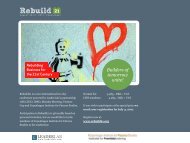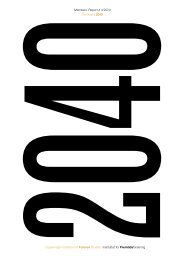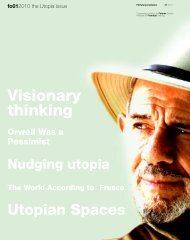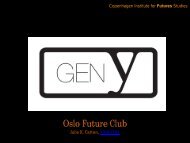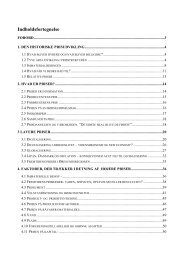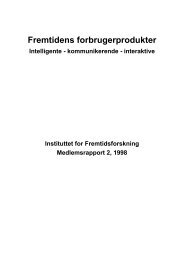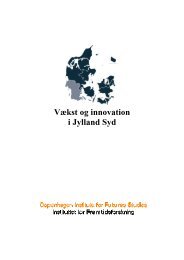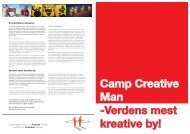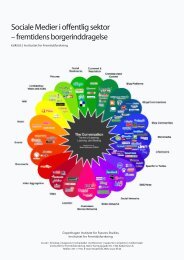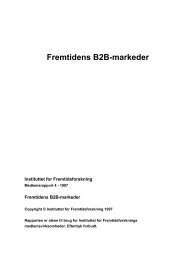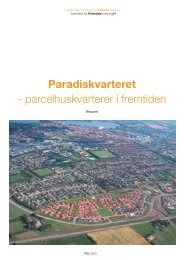Branding.
Branding.
Branding.
Create successful ePaper yourself
Turn your PDF publications into a flip-book with our unique Google optimized e-Paper software.
27<br />
sure time is corroding. Values are correspondingly personal and are continually<br />
negotiated in the eternal exchange of information between actors in the individual's<br />
environment. Categorical truths are only for the narrow-minded. And if<br />
a company's values are so broadly stated that we all can agree about them,<br />
we might as well not have them. Communication is difference; everything<br />
else is increasingly perceived as 'hot air'.<br />
The little rational story wins<br />
Hence, the conquering story is the little story about the product that makes a difference<br />
compared to other products or really changes the buyer's possibili-ties.<br />
The brands that have survived the change to the rational paradigm are those<br />
that in their marketing have created a correspondence between performance<br />
and story. Brands that have kept their internal logic from the turn of the millennium<br />
and still are successful are, among others, Louis Poulsen, B&O, Avis (We<br />
Try Harder) and Maersk (punctual diligence). Stories about value for money.<br />
In this respect it marks a return to the old ideas about the product as the<br />
hero (or the buyer as hero through the product). Though with the difference<br />
that we increasingly are critical of the real and functional product advantages.<br />
The spectacular staging of the consumer's needs, which we saw in the<br />
past, is on the wane along with the emotional argument. Especially the new<br />
generations on the labour market are very conscious about what requirements<br />
they have - and how to fulfil them. The 80's mentality of our childhood<br />
is still in fresh memory.<br />
The old market structure in decline<br />
Around the turn of the millennium most companies were set in a way of<br />
thought that very much was historically based. Back then, the market structure<br />
for most companies could be fit into a vertical model where the movement<br />
was from producer to consumer (see page 7). The trend now is that<br />
this market concept and the logic behind it are in decline.<br />
The new successful companies increasingly dissolve the boundary between<br />
'consumer' and 'producer' and organise their company like a network<br />
based on a decisive will to create transparency and frictionless communication<br />
possibilities. The movement is increasingly going from user to producer,<br />
and all involved parties can follow the process.<br />
VELUX IN 'THE RATIONAL<br />
INDIVIDUALS' 2013<br />
Our organisation is based on the<br />
market structure of the new age.<br />
Things increasingly revolve around<br />
the customers. Their individual<br />
product needs trigger our production<br />
- and it is difficult to see<br />
where the company begins and<br />
ends. Customers, suppliers, producers,<br />
and distributors are all<br />
part of the same network. They<br />
find each other through project<br />
folders on the internet. The brand<br />
of VELUX is today far better adapted<br />
to the individual stakeholder<br />
groups. Also for the employees,<br />
which have optimal conditions for<br />
individual development and working<br />
from home.<br />
We have always had Product<br />
Power, but now we can set aside<br />
far more resources for development<br />
and optimisation of our core<br />
products. For instance, new functional<br />
windowpanes have seen the<br />
light of day. They can do far more<br />
than just insulate against heat and<br />
cold - they can e.g. create energy<br />
for the home through solar cells.<br />
The ongoing developments constantly<br />
vitalise the story of VELUX,<br />
which now increasingly focuses<br />
on the original basis: innovative<br />
engineering<br />
Mass customisation<br />
At the same time far fewer standard products are produced and far fewer<br />
fixed services are sold. Today nearly everything is produced directly from<br />
the end-users desires and specifications. Mass customisation has truly replaced<br />
mass production. The consumer is no longer a passive consumer, but an<br />
active co-producer - a prosumer.<br />
It becomes ever easier and cheaper to give the products you buy individual<br />
characteristics. The general availability of print on demand technology<br />
e.g. provides remarkable choices when buying a book. Should the book be in<br />
small or large format? Hardcover or paperback? Printed on cheap or quality<br />
paper? The bookstore has become a portal for all the book publishers of the<br />
world, which in return no longer need to bother with printing. Many electronic<br />
stores have also begun using 'gadget printers' that provide on-the-spot<br />
production of e.g. mobile phones, remote controls and pocket calculators<br />
according to the customer's specifications.<br />
<strong>Branding</strong> has come full circle<br />
In this way the history of branding has come full circle. With corporate branding<br />
the focus was directed at the company after a period with the focus on the<br />
product and the corporate brand (see page 5), but now we have come all the




